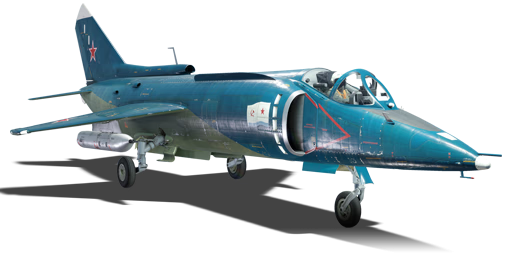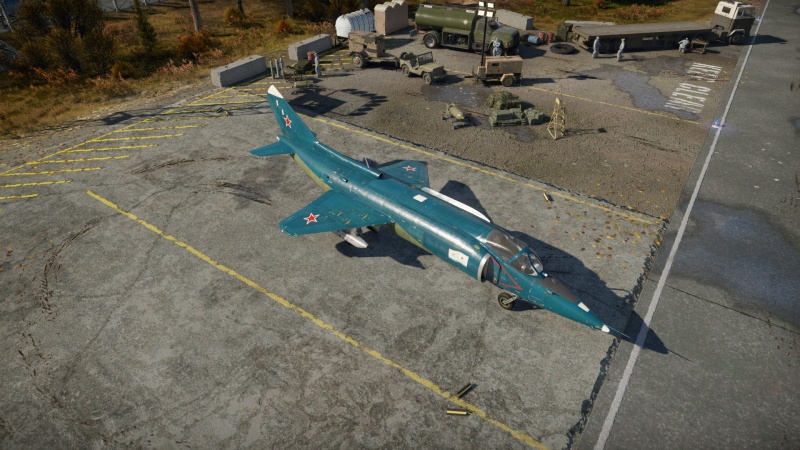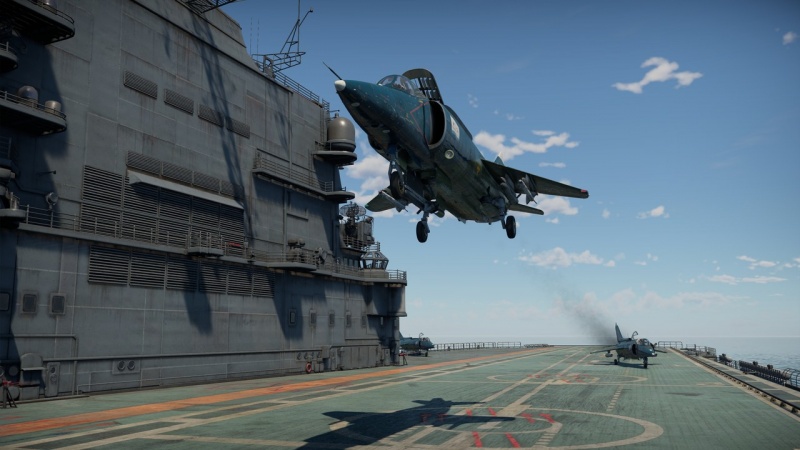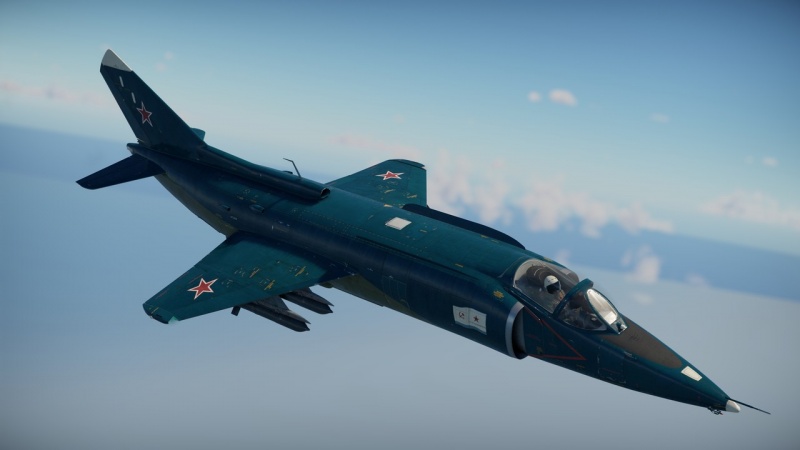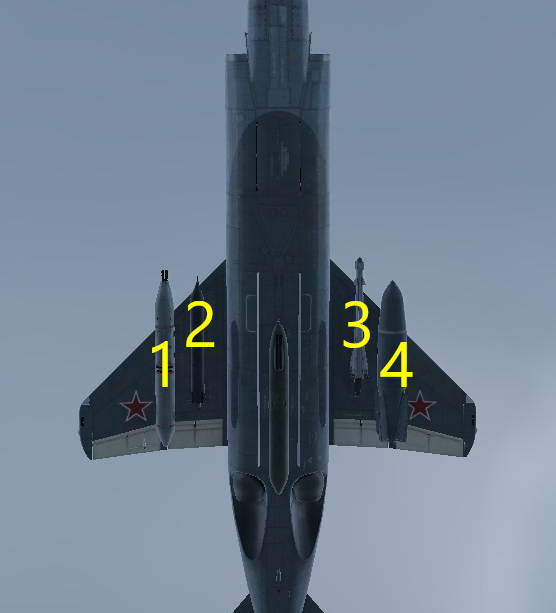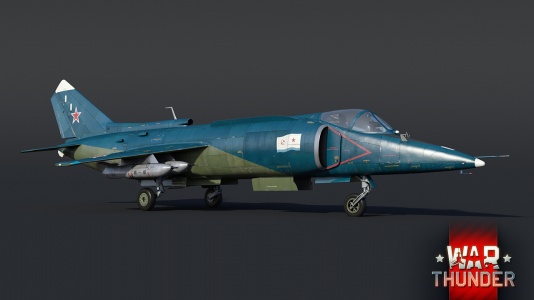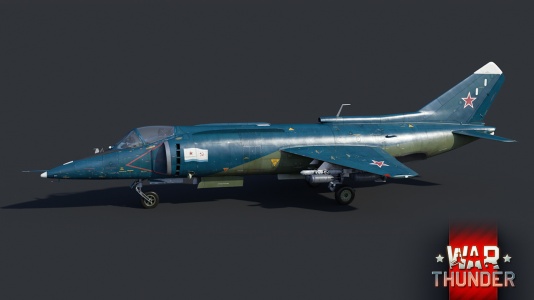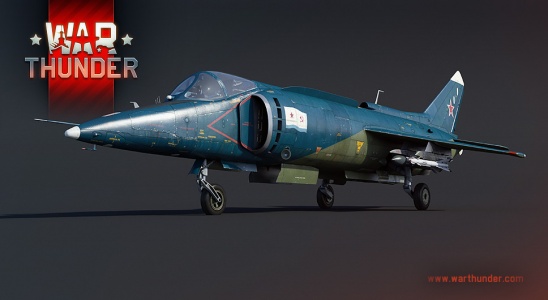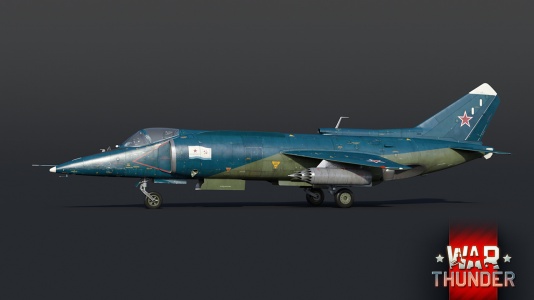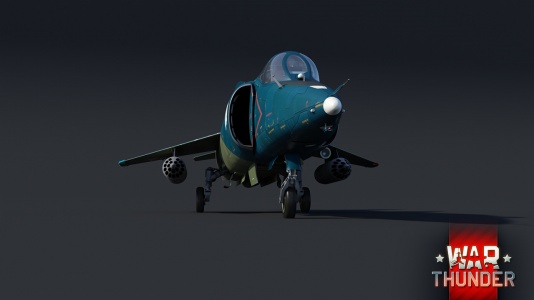Difference between revisions of "Yak-38"
(→Description) |
(→Armaments: Reformatted) |
||
| Line 146: | Line 146: | ||
The '''''{{PAGENAME}}''''' is armed with: | The '''''{{PAGENAME}}''''' is armed with: | ||
| − | + | * 1 x 23 mm GSh-23L cannon, belly-mounted (160 rpg) | |
| − | |||
| − | |||
=== Suspended armament === | === Suspended armament === | ||
{{Specs-Avia-Suspended}} | {{Specs-Avia-Suspended}} | ||
<!-- ''Describe the aircraft's suspended armament: additional cannons under the wings, bombs, rockets and torpedoes. This section is especially important for bombers and attackers. If there is no suspended weaponry remove this subsection.'' --> | <!-- ''Describe the aircraft's suspended armament: additional cannons under the wings, bombs, rockets and torpedoes. This section is especially important for bombers and attackers. If there is no suspended weaponry remove this subsection.'' --> | ||
| − | |||
| − | |||
| − | The '''''{{PAGENAME}}''''' can be outfitted with the following ordnance | + | The '''''{{PAGENAME}}''''' can be outfitted with the following ordnance: |
| − | |||
| − | |||
| − | |||
| − | |||
| − | |||
| − | |||
| − | |||
| − | |||
| − | |||
| − | |||
| − | |||
| − | |||
| − | |||
| − | |||
| − | |||
{| class="wikitable" style="text-align:center" width="100%" | {| class="wikitable" style="text-align:center" width="100%" | ||
|- | |- | ||
| Line 178: | Line 159: | ||
| rowspan="13" width="30%" | <div class="ttx-image">[[File:Hardpoints_Yak-38M.png]]</div> | | rowspan="13" width="30%" | <div class="ttx-image">[[File:Hardpoints_Yak-38M.png]]</div> | ||
|- | |- | ||
| − | ! 23 mm GSh-23L cannons (250 rpg) | + | ! [[GSh-23L (23 mm)|23 mm GSh-23L]] cannons (250 rpg) |
| 1 || 1 || 1 || 1 | | 1 || 1 || 1 || 1 | ||
|- | |- | ||
| − | ! 100 kg OFAB-100 bombs | + | ! [[OFAB-100 (100 kg)|100 kg OFAB-100]] bombs |
| 4 || 1 || 1 || 4 | | 4 || 1 || 1 || 4 | ||
|- | |- | ||
| − | ! 250 kg OFAB-250sv bombs | + | ! [[OFAB-250sv (250 kg)|250 kg OFAB-250sv]] bombs |
| 1 || 1 || 1 || 1 | | 1 || 1 || 1 || 1 | ||
|- | |- | ||
| − | ! 500 kg FAB-500M-54 bombs | + | ! [[FAB-500M-54 (500 kg)|500 kg FAB-500M-54]] bombs |
| 1 || || || 1 | | 1 || || || 1 | ||
|- | |- | ||
| − | ! ZB-500 incendiary bombs | + | ! [[ZB-500 incendiary]] bombs |
| 1 || || || 1 | | 1 || || || 1 | ||
|- | |- | ||
| − | ! S-5KP rockets | + | ! [[S-5KP]] rockets |
| 16, 32 || 16 || 16 || 16, 32 | | 16, 32 || 16 || 16 || 16, 32 | ||
|- | |- | ||
| − | ! S-8KO rockets | + | ! [[S-8KO]] rockets |
| 20 || || || 20 | | 20 || || || 20 | ||
|- | |- | ||
| − | ! S-24B rockets | + | ! [[S-24B]] rockets |
| 1 || 1 || 1 || 1 | | 1 || 1 || 1 || 1 | ||
|- | |- | ||
| − | ! Kh-23M missiles | + | ! [[Kh-23M]] missiles |
| 1* || || || 1* | | 1* || || || 1* | ||
|- | |- | ||
| − | ! R-60 missiles | + | ! [[R-60]] missiles |
| 1 || 1 || 1 || 1 | | 1 || 1 || 1 || 1 | ||
|- | |- | ||
| − | ! Delta-NG | + | ! Delta-NG targeting pod |
| || || 1* || | | || || 1* || | ||
|- | |- | ||
| Line 215: | Line 196: | ||
| colspan="6" | * Delta-NG targeting pod must be carried when equipping Kh-23M missiles | | colspan="6" | * Delta-NG targeting pod must be carried when equipping Kh-23M missiles | ||
|} | |} | ||
| + | |||
| + | {{Navigation-Start|Default weapon presets}} | ||
| + | {{Navigation-First-Simple-Line}} | ||
| + | * 2 x 23 mm GSh-23L cannons (250 rpg = 500 total) | ||
| + | * 2 x R-60 missiles | ||
| + | * 4 x R-60 missiles | ||
| + | * 64 x S-5KP rockets | ||
| + | * 64 x S-5KP rockets | ||
| + | * 40 x S-8KO rockets | ||
| + | * 4 x S-24B rockets | ||
| + | * 2 x Kh-23M missiles | ||
| + | * 10 x 100 kg OFAB-100 bombs (1,000 kg total) | ||
| + | * 4 x 250 kg OFAB-250sv bombs (1,000 kg total) | ||
| + | * 2 x 500 kg FAB-500M-54 bombs (1,000 kg total) | ||
| + | * 2 x ZB-500 incendiary bombs | ||
| + | * 4 x 23 mm GSh-23L cannons (250 rpg = 1,000 total) | ||
| + | {{Navigation-End}} | ||
== Usage in battles == | == Usage in battles == | ||
Revision as of 08:40, 29 September 2023
| This page is about the premium Soviet strike aircraft Yak-38. For the regular version, see Yak-38M. |
Contents
Description
During the late 1960s, Yakovlev Design Bureau set out to build the Soviet Union's first VTOL fighter, after witnessing the success of the Hawker P.1154 VTOL testbed from Great Britain. Initially lacking funding for research and development of proper VTOL technology, Yakovlev presented the Yak-36 created with what little they had. The Yak-36 was a failure by most metrics, with only four built and only one performing VTOL flight, which later crashed in testing. However, to Yakovlev it was a massive success, as this design convinced the Soviet government to fund the development of a proper Soviet VTOL program. Yakovlev presented a supersonic design with swivelling nozzles similar to those found on the Harrier family, but this was deemed too complex and expensive. Instead, the Soviet government ordered a simpler, cheaper VTOL aircraft primarily for naval operation aboard their new Project 1143 Heavy Aircraft Cruisers. This new aircraft would be limited in speed to Mach 0.95, and would function as both a fleet defence fighter, armed with air-to-air missiles for interception, and also as a naval strike fighter, carrying a multitude of both guided and unguided ordnance. Yakovlev OKB got to work, and on September 22nd, 1970, the first prototype of the Yak-38 performed its maiden flight. However, with new technology came many problems, and the Yak-38 would be plagued by an unacceptable amount of issues, which took many years to fix, before the Yak-38 officially entered service six years later in 1976.
The Yak-38 was introduced as a premium pack in Update "New Power" but was removed from the store after the 2022 Summer sale. The aircraft returned on the 22nd of September 2023 for the 52nd anniversary of its maiden flight as a premium purchasable using GE ![]() . Being a VTOL aircraft (Vertical Take-Off and Landing), the Yak-38 can perform stationary flight, offering new gameplay possibilities compared to conventional jet aircraft. However, like its tech tree equivalent, the Yak-38M, it is seriously underwhelming in conventional flight performance. However, what it lacks in flying is compensated by the powerful ordnance this aircraft can carry. It is armed with the formidable R-60 air-to-air missile, and its ground striking ordnance is no slouch either, with a selection of rocket pods, bombs, gunpods, and even the Kh-23M guided air-to-ground missile. All in all, this aircraft's play style serves more as a stepping stone, teaching the player how to work with a sub-optimal airframe that relies completely on its strong weapons to to well, as all other Yakovlev VTOL aircraft work with the same principle.
. Being a VTOL aircraft (Vertical Take-Off and Landing), the Yak-38 can perform stationary flight, offering new gameplay possibilities compared to conventional jet aircraft. However, like its tech tree equivalent, the Yak-38M, it is seriously underwhelming in conventional flight performance. However, what it lacks in flying is compensated by the powerful ordnance this aircraft can carry. It is armed with the formidable R-60 air-to-air missile, and its ground striking ordnance is no slouch either, with a selection of rocket pods, bombs, gunpods, and even the Kh-23M guided air-to-ground missile. All in all, this aircraft's play style serves more as a stepping stone, teaching the player how to work with a sub-optimal airframe that relies completely on its strong weapons to to well, as all other Yakovlev VTOL aircraft work with the same principle.
General info
Flight performance
| Characteristics | Max Speed (km/h at 0 m - sea level) |
Max altitude (metres) |
Turn time (seconds) |
Rate of climb (metres/second) |
Take-off run (metres) | |||
|---|---|---|---|---|---|---|---|---|
| AB | RB | AB | RB | AB | RB | |||
| Stock | 1,190 | 1,186 | 12500 | 40.0 | 41.2 | 77.4 | 70.5 | 520 |
| Upgraded | 1,207 | 1,199 | 37.3 | 38.6 | 113.1 | 94.3 | ||
Details
| Features | |||||
|---|---|---|---|---|---|
| Combat flaps | Take-off flaps | Landing flaps | Air brakes | Arrestor gear | Drogue chute |
| X | ✓ | ✓ | X | X | ✓ |
| Limits | ||||||
|---|---|---|---|---|---|---|
| Wings (km/h) | Gear (km/h) | Flaps (km/h) | Max Static G | |||
| Combat | Take-off | Landing | + | - | ||
| 1265 | 500 | N/A | 650 | 500 | ~12 | ~5 |
| Optimal velocities (km/h) | |||
|---|---|---|---|
| Ailerons | Rudder | Elevators | Radiator |
| < 650 | < 850 | < 920 | N/A |
Engine performance
| Engine | Aircraft mass | |||||
|---|---|---|---|---|---|---|
| Engine name | Number | Basic mass | Wing loading (full fuel) | |||
| Tumansky R-27V-300 (main) | 1 | 6,645 kg | 502 kg/m2 | |||
| Kolesov RD-36-35FV (lift jets) | 2 | |||||
| Engine characteristics | Mass with fuel (no weapons load) | Max Takeoff Weight | ||||
| Weight (each) | Type | 7m fuel | 20m fuel | 23m fuel | ||
| 1,350 kg (main) | Vectored-thrust axial-flow turbojet | 7,470 kg | 8,939 kg | 9,395 kg | 10,300 kg | |
| 198 kg (lift jet) | Axial-flow turbojet | |||||
| Maximum main engine thrust @ 0 m (RB / SB) | Thrust to weight ratio in forward flight @ 0 m (100%) | |||||
| Condition | 100% | WEP | 7m fuel | 20m fuel | 23m fuel | MTOW |
| Stationary | 6,600 kgf | N/A | 0.88 | 0.73 | 0.70 | 0.64 |
| Optimal | 6,600 kgf (0 km/h) |
N/A | 0.88 | 0.73 | 0.70 | 0.64 |
| Maximum lift engine thrust @ 0 m (RB / SB) | Thrust to weight ratio in VTOL (all 3 engines) @ 0 m (100%) | |||||
| Stationary | 2,840 kgf | N/A | 1.64 | 1.37 | 1.31 | 1.19 |
Survivability and armour
The Yak-38 has no armour. It is a fairly large target with the entire fuselage being taken up with engines and fuel tanks.
Modifications and economy
Armaments
| Ballistic Computer | |||
|---|---|---|---|
| CCIP (Guns) | CCIP (Rockets) | CCIP (Bombs) | CCRP (Bombs) |
| |
|
|
|
Offensive armament
The Yak-38 is armed with:
- 1 x 23 mm GSh-23L cannon, belly-mounted (160 rpg)
Suspended armament
The Yak-38 can be outfitted with the following ordnance:
| 1 | 2 | 3 | 4 | ||
|---|---|---|---|---|---|
| 23 mm GSh-23L cannons (250 rpg) | 1 | 1 | 1 | 1 | |
| 100 kg OFAB-100 bombs | 4 | 1 | 1 | 4 | |
| 250 kg OFAB-250sv bombs | 1 | 1 | 1 | 1 | |
| 500 kg FAB-500M-54 bombs | 1 | 1 | |||
| ZB-500 incendiary bombs | 1 | 1 | |||
| S-5KP rockets | 16, 32 | 16 | 16 | 16, 32 | |
| S-8KO rockets | 20 | 20 | |||
| S-24B rockets | 1 | 1 | 1 | 1 | |
| Kh-23M missiles | 1* | 1* | |||
| R-60 missiles | 1 | 1 | 1 | 1 | |
| Delta-NG targeting pod | 1* | ||||
| Maximum permissible weight imbalance: 450 kg | |||||
| * Delta-NG targeting pod must be carried when equipping Kh-23M missiles | |||||
| Default weapon presets | |
|---|---|
| |
Usage in battles
The Yak-38 is one of the most versatile aircraft in the Soviet tech tree as it has sufficient armament for all sorts of engagements: air-to-air, air-to-ground, air-to-sea. Thanks to its VTOL capabilities, it is able to achieve a "helicopter" playstyle if needed.
When in air battles
The Yak-38 has an impressive sort of armaments for all engagements when in air battles. It can be used as a standard fighter with gunpods, ground units destroyer with gunpods, rockets, missiles and bombs or as a missile fighter with its potent R-60 air-to-air missiles.
As a fighter:
The Yak-38 has 2 effective loadouts in Air RB. The 1st option is 4 x R-60 air-to-air missiles, which are highly manoeuvrable in short to medium range engagements, and can prove extremely potent against opponents at the battle rating, especially if they cannot use flares to counter them. The other option is to trade 2 of the R-60s for 2 x S-24 air to ground rockets. S-24 rockets have time-fuse capability; setting the time fuse to 1,000 m and shooting the rockets in a head-on at about 1.7-1.5 km distance could result in a kill, surprising your target (it is recommended to shoot both rockets in a quick succession). S-24 rockets can also act as pseudo-flares, just shoot one of them and dodge the other way when a potent IR missile is closing onto to you.
The Yak-38 has access to up to 4 rapid-firing 23 mm gunpods, capable of destroying ground units such as artillery, anti-air emplacements, armoured vehicles and even lightly-armoured vessels such as cargo ships. However, it is not recommended to bring the gunpods at the beginning of the match because it severely limits your performance and air-combat capabilities, use this loadout at the end of the game to ground pound when you are sure of victory. J out once landed and repaired on the airfield to change your loadout.
As a ground striker:
The ground ordnance on the Yak-38 leaves nothing to be desired, it carries a vast array of bomb, rockets and missiles loads which can be taken according to the situation. It has access to S-5KP unguided rockets which can be used against pillboxes, armoured vehicles such as tanks, enemy vessels such as destroyers and even enemy bases (not recommended as the TNT equivalent is really low compared to bombs). It has access to CCIP ballistic computer which make the aiming of suspended ordnance a really easy task when doing CAS strikes.
As a bomber:
Thanks to the bomb payload the Yak-38 carries, it is able to act as a low level lightning strike bomber (flying close to the ground as fast as possible) although it is not recommended as the payload it carries is not enough to take a single base completely (2 x 500 kg and 2 x 250 kg bombs). Playing as a bomber is not recommended in terms of cost-benefit but it is up to pilot's discretion.
When landing
Normal Landing:
If you are coming in for a landing, you need to get rid of your speed first. Unfortunately the Yak-38 has no airbrakes and weak flaps, so you can't easily reduce your speed if you are flying past 500 km/h with your flaps only. When you are close to the airport, manoeuvre in circles until you have gotten rid of your speed. Once your speed has significantly reduced, move to the end of the runway and put your gear down and the flaps too if needed.
VTOL landing:
Approach the airport and get rid of your speed. When you have reached the conventional landing speed, slowly increase the VTOL (with no engine power the VTOL has no power) and lift the plane so you can get rid of the remaining speed. When you have no forward movement left, you can turn on hover-mode and slowly remove the hover power (0% is stationary height, 100% is increasing height, -100% is lowering height). Reduce the hover power to 0 when close to the ground and avoid making contact with -100% hover power.
When in ground battles
This is the place where the Yak-38 shines, thanks to an unusual suspended ordnance, the manually-guided Kh-23M air-to-ground missile. The Kh-23M missile is controlled by the player via keyboard input like like other manually-guided missiles such as the Nord and Bullpup missile. Despite only being able to carry 2 missiles, each one can be a knock-out if used correctly. Use them in a top attack preferably at an azimuth greater than 35° from the target so that the missile has clear line of sight with zero obstructions (fences, trees, buildings, etc) and is able to penetrate the roof as it has a really low armour penetration. The missile is able to be fired at a 10 km range from the target although it is not recommended to do so unless the pilot is very skilled in terms of controlling manually guided missiles. Besides the Kh-23M, the Yak-38 has access to bombs and rockets which can be used with the ballistic computer to make pinpoint accuracy attacks on enemy targets. It is up to pilot's discretion to decide the suspended ordnance carried.
Pros and cons
Pros:
- VTOL capability
- Fast acceleration - one of the fastest subsonic jets, can quickly hit Mach 0.98 in level flight!
- Plenty of payload options (20 setups)
- Has access to the very efficient S-24B rockets and Kh-23M AGMs, as well as R-60 AAMs
- CCIP for its guns and rockets mean you can easily target enemy ground units - S-24B rockets are especially effective
Cons:
- Subsonic
- Very small elevators with poor high-speed performance means slow turns
- Massive energy loss during high speed turns
- Cannot use thrust vectoring in cruise flight or combat, unlike the Harriers - nozzles and lift engines automatically disengage at cruise speed
- No airbrakes, can be difficult to bleed enough speed for a regular landing, though it can use its VTOL engines as an airbrake once slower than 500 km/h
- Vertical landings require careful consideration of your velocity bleed.
- Somewhat fragile gear means careless landings can cause the plane to smash into the strip or carrier deck
- Very high RPM combined with low RPG count means you have to be very careful when using the gun(s)
History
Devblog
Although Soviet engineers were experimenting with VTOL fixed wing aircraft design since the early 1960s, it wasn't until December 1967 before a formal order to develop a light VTOL strike aircraft as well as a corresponding trainer version was issued. As a result, engineers at the Yakovlev design bureau began work on the new aircraft in the late 1960s, basing their design on experience gained from developing the preceding Yak-36 - an early VTOL demonstration design.
The new aircraft, designated Yak-36M, was being developed for immediate frontline service, operating both from land bases as well as aircraft-carrying ships. The aircraft's primary role was that of a strike aircraft, engaging ground and surface targets while also being suited to intercept enemy aircraft and helicopters if necessary.
Not too long after work on the project began, the first prototype saw completion and conducted its maiden flight in December 1970. Subsequent prototypes and trials continued testing the aircraft's performance, particularly its novel VTOL capabilities. By 1973, the aircraft was considered ready and serial production commenced.
After some further testing and crew training, the aircraft officially entered service with the Soviet Navy in August 1977, receiving the designation Yak-38. By 1982, over 140 Yak-38s were built, all of which served aboard the then new Kiev-class aircraft carriers. In the mid 1980s, the modernized Yak-38M version came into service, most prominently featuring more powerful engines as well as other improvements. About 50 Yak-38M were built before the type was ultimately decommissioned in 1991.
Media
- Skins
- Images
- Yak-38 Devblog Images
- Videos
See also
External links
| A.S. Yakovlev Design Bureau (Яковлев Опытное конструкторское бюро) | |
|---|---|
| Fighters | |
| Yak-1 | Yak-1 · Yak-1B |
| Yak-3 | Yak-3 · Eremin's Yak-3(e) · Yak-3 (VK-107) · Yak-3P · Yak-3T · Yak-3U |
| Yak-7 | Yak-7B |
| Yak-9 | Yak-9 · Yak-9B · Yak-9K · Golovachev's Yak-9M · Yak-9P · Yak-9T · Yak-9U · Yak-9UT |
| Twin-engine fighters | I-29 |
| Jet fighters | |
| Yak-15 | Yak-15P · Yak-15 |
| Yak-17 | Yak-17 |
| Yak-23 | Yak-23 |
| Yak-30 | Yak-30D |
| Yak-141 | Yak-141 |
| Strike aircraft | |
| Yak-2 | Yak-2 KABB |
| Yak-38 | Yak-38 · Yak-38M |
| Bombers | Yak-4 |
| Jet bombers | Yak-28B |
| Foreign use | ▄Yak-3 · Challe's ▄Yak-9T · ◔Yak-9P |
| Captured | ▀Yak-1B |
| USSR jet aircraft | |
|---|---|
| Bereznyak-Isayev | BI |
| Yakovlev | Yak-15 · Yak-15P · Yak-17 · Yak-23 · Yak-28B · Yak-30D · Yak-38 · Yak-38M · Yak-141 |
| Mikoyan-Gurevich | MiG-9 · MiG-9 (l) · MiG-15 · MiG-15bis · MiG-15bis ISh · MiG-17 · MiG-17AS · MiG-19PT |
| MiG-21F-13 · MiG-21PFM · MiG-21S (R-13-300) · MiG-21SMT · MiG-21bis | |
| MiG-23M · MiG-23ML · MiG-23MLD · MiG-27M · MiG-27K | |
| MiG-29 · MiG-29SMT | |
| Lavochkin | La-174 · La-15 · La-200 |
| Sukhoi | Su-9 · Su-11 |
| Su-7B · Su-7BKL · Su-7BMK · Su-17M2 · Su-17M4 · Su-22M3 | |
| Su-24M | |
| Su-25 · Su-25BM · Su-25K · Su-25T · Su-25SM3 · Su-39 | |
| Su-27 · Su-27SM | |
| Su-34 | |
| Ilyushin | IL-28 · IL-28Sh |
| Tupolev | Tu-14T |
| USSR premium aircraft | |
|---|---|
| Fighters | Krasnolutsky's I-15bis · I-16 type 28 · Zhukovsky's I-153-M62 · I-153P · I-180S · I-301 · ITP (M-1) |
| LaGG-3-4 · LaGG-3-23 · LaGG-3-34 · Dolgushin's La-7 · La-11 | |
| Eremin's Yak-3(e) · Yak-3 (VK-107) · Yak-3T · Golovachev's Yak-9M | |
| ▂P-39K-1 · ▂Pokryshkin's P-39N-0 · ▂P-39Q-15 · ▂P-40E-1 · ▂P-47D-27 · ▂P-63A-5 · ▂P-63A-10 · ▂P-63C-5 | |
| ▂Hurricane Mk IIB · ▂Spitfire Mk IXc · ▂Fw 190 D-9 | |
| Twin-engine fighters | I-29 |
| Jet fighters | Su-11 · MiG-15bis ISh · MiG-17AS · MiG-21S (R-13-300) · MiG-23ML |
| Strike aircraft | IL-2M "Avenger" · IL-2 M-82 · IL-8 (1944) · Su-6 · Tandem MAI · TIS MA · Su-8 · Tu-1 |
| Yak-38 · Su-7BMK · Su-25K · Su-39 | |
| Bombers | Po-2M · Be-6 · MBR-2-M-34 · Pe-2-205 · TB-3M-17-32 |
| ▂PBY-5A Catalina · ▂Hampden TB Mk I · ▂A-20G-30 · ▂B-25J-30 | |


